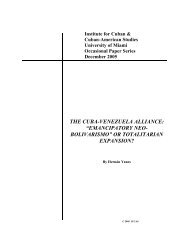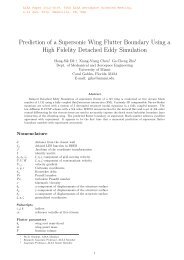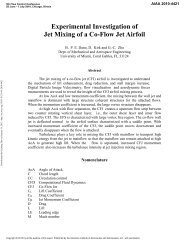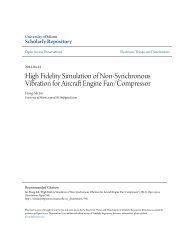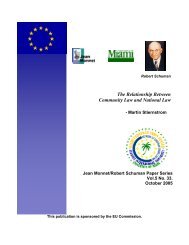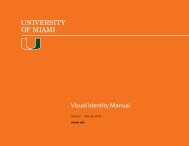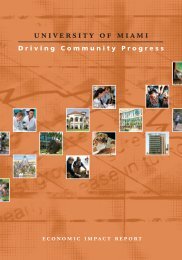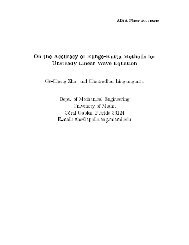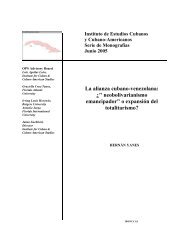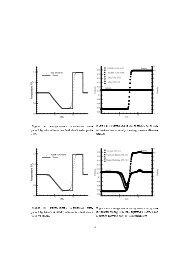The Assimilation of Immigrant Groups in France - University of Miami
The Assimilation of Immigrant Groups in France - University of Miami
The Assimilation of Immigrant Groups in France - University of Miami
Create successful ePaper yourself
Turn your PDF publications into a flip-book with our unique Google optimized e-Paper software.
Robert Schuman<strong>The</strong> <strong>Assimilation</strong> <strong>of</strong> <strong>Immigrant</strong> <strong>Groups</strong> <strong>in</strong> <strong>France</strong>—Myth or Reality?- Eloisa VladescuJean Monnet/Robert Schuman Paper SeriesVol. 5 No. 392006This publication is sponsored by the EU Commission
<strong>The</strong> Jean Monnet/Robert Schuman Paper Series<strong>The</strong> Jean Monnet/Robert Schuman Paper Series is produced by the Jean Monnet Chair <strong>of</strong>the <strong>University</strong> <strong>of</strong> <strong>Miami</strong>, <strong>in</strong> cooperation with the <strong>Miami</strong> European Union Center.<strong>The</strong>se monographic papers analyze ongo<strong>in</strong>g developments with<strong>in</strong> the European Union aswell as recent trends which <strong>in</strong>fluence the EU’s relationship with the rest <strong>of</strong> the world.Broad themes <strong>in</strong>clude, but are not limited to:♦ EU Enlargement♦ <strong>The</strong> Evolution <strong>of</strong> the Constitutional Process♦ <strong>The</strong> EU as a Global Player♦ Comparative Regionalisms♦ <strong>The</strong> Trans-Atlantic Agenda♦ EU-Lat<strong>in</strong> American Relations♦ Economic issues♦ Governance♦ <strong>The</strong> EU and its Citizens♦ EU LawAs the process <strong>of</strong> European <strong>in</strong>tegration evolves further, the Jean Monnet/Robert SchumanPapers is <strong>in</strong>tended to provide current analyses on a wide range <strong>of</strong> issues relevant to theEU. <strong>The</strong> overall purpose <strong>of</strong> the monographic papers is to contribute to a betterunderstand<strong>in</strong>g <strong>of</strong> the unique nature <strong>of</strong> the EU and the significance <strong>of</strong> its role <strong>in</strong> the world.<strong>Miami</strong> European Union Center Jean Monnet Chair Staff:<strong>University</strong> <strong>of</strong> <strong>Miami</strong>Joaquín Roy (Director)1000 Memorial Drive Markus Thiel (Research Associate)101 Ferré Build<strong>in</strong>g Eloisa Vladescu (Editorial Assistant)Coral Gables, FL 33124-2231 Cather<strong>in</strong>e Cottrell (Editorial Assistant)Phone: 305-284-3266Fax: (305) 284 4406E-Mail: jroy@miami.eduWeb: www.miami.edu/eucenter
<strong>The</strong> <strong>Assimilation</strong> <strong>of</strong> <strong>Immigrant</strong> <strong>Groups</strong> <strong>in</strong> <strong>France</strong>—Myth or Reality?Eloisa Vladescu ∗<strong>The</strong> Jean Monnet Chair<strong>University</strong> <strong>of</strong> <strong>Miami</strong><strong>Miami</strong>, FloridaJuly 2006∗ Eloisa Vladescu Eloisa Vladescu (M.A. <strong>in</strong> International Studies, B.A. <strong>in</strong> Political Science, IR and French)is responsible for the logistics <strong>of</strong> the <strong>Miami</strong> European Union Center. She coord<strong>in</strong>ates the Center’sconferences and guest lectures, contributes articles and papers to its publications, and works to balance itsbudget. She is currently pursu<strong>in</strong>g her Ph.D. <strong>in</strong> International Studies and is focus<strong>in</strong>g on the significantimmigration issues affect<strong>in</strong>g most European Union member states today. Eloisa is fluent <strong>in</strong> English,French, Romanian and Spanish and looks forward to contribut<strong>in</strong>g to the EU Center through her research.
<strong>The</strong> <strong>Assimilation</strong> <strong>of</strong> <strong>Immigrant</strong> <strong>Groups</strong> <strong>in</strong> <strong>France</strong>—Myth or Reality?IntroductionS<strong>in</strong>ce the French Revolution <strong>of</strong> 1789, the French state has emerged as an entity designedto manage a civic nation <strong>in</strong> which anyone who wants to be French can <strong>in</strong> fact become aFrench citizen. For centuries, the French territory has been <strong>in</strong>habited by people <strong>of</strong>different l<strong>in</strong>guistic and cultural backgrounds. Napoleon Bonaparte and his followers ledthe struggle to unify, <strong>in</strong> many cases forcibly, these various groups <strong>in</strong> order to transformthe former k<strong>in</strong>gdom <strong>in</strong>to his nationalistic vision <strong>of</strong> “la République Française”. A specifictype <strong>of</strong> French would become the <strong>of</strong>ficial language <strong>of</strong> the state, the educational systemwould become the tool <strong>of</strong> the state to mold and condition future citizens, and an<strong>in</strong>creas<strong>in</strong>gly homogeneous French culture would emerge over time. Although some <strong>of</strong>these unify<strong>in</strong>g measures might be considered extreme by today’s standards, many <strong>of</strong> theunderly<strong>in</strong>g concepts are still be<strong>in</strong>g used <strong>in</strong> the transition from foreigners to Frenchcitizens. <strong>France</strong> has had a long history <strong>of</strong> immigration, both from neighbor<strong>in</strong>g countriesas well as from many other parts <strong>of</strong> the world. <strong>The</strong> reasons for the emigration <strong>of</strong> variouspeoples from their countries <strong>of</strong> orig<strong>in</strong> are <strong>of</strong>ten quite different <strong>in</strong> both scope andcircumstance. Despite these differences, immigrants <strong>in</strong> <strong>France</strong> have all shared some <strong>of</strong>the same experiences, difficulties and benefits. <strong>The</strong> question that needs to be answered iswhether the <strong>in</strong>tegration <strong>of</strong> particular immigrant groups is a myth or reality. <strong>The</strong> Frenchstate has been relatively successful <strong>in</strong> nationaliz<strong>in</strong>g many <strong>of</strong> its immigrants, but thedegree to which each group has been assimilated <strong>in</strong>to French society varies and muchwork rema<strong>in</strong>s to be done to ensure that none <strong>of</strong> them becomes marg<strong>in</strong>alized <strong>in</strong> the future.In order to understand the way <strong>in</strong> which French immigration and assimilationhave evolved over time, it is essential to exam<strong>in</strong>e the historical background that has laidthe foundations <strong>of</strong> today’s French state and society. A historical overview will alsoprovide the appropriate context <strong>in</strong> which to analyze the complex social, economic andpolitical dilemmas that have emerged and affected both immigration and <strong>in</strong>tegration. Aspreviously mentioned, the French territory was occupied by various l<strong>in</strong>guistic andcultural groups that settled <strong>in</strong> this region more than two thousand years ago. Although theCeltic tribes orig<strong>in</strong>ally occupied “la Gaulle”, the conquest <strong>of</strong> this territory by the Romansopened the doors to the immigration <strong>of</strong> the other groups. As the Roman Empire began toweaken, the Franks began to take control <strong>of</strong> Gaul. By the middle <strong>of</strong> the first millenniumA.D., the Franks had managed to not only unify the Visigoths, Burgundii and othergroups, but they were also relatively successful <strong>in</strong> convert<strong>in</strong>g these peoples to theChristian faith. Later, the Merov<strong>in</strong>gian and the Carol<strong>in</strong>gian k<strong>in</strong>gs would cont<strong>in</strong>ue themission <strong>of</strong> unify<strong>in</strong>g, and <strong>in</strong> many cases subord<strong>in</strong>at<strong>in</strong>g, various local and foreign groups.<strong>The</strong>se events set the stage for the k<strong>in</strong>ds <strong>of</strong> policies that Napoleon Bonaparte wouldeventually adopt one thousand years later to create the French Republic.1
By the last part <strong>of</strong> the first millennium, Vik<strong>in</strong>g <strong>in</strong>vaders managed to weaken theFranks and split the country up <strong>in</strong>to various regions, each ruled by its own set <strong>of</strong> nobles.In fact some regions, <strong>in</strong>clud<strong>in</strong>g Aquita<strong>in</strong>e, Burgundy, Flanders, Anjou, Blois andNormandy, actually considered themselves completely <strong>in</strong>dependent states. Ignor<strong>in</strong>g many<strong>of</strong> the claims to <strong>in</strong>dependence, the Capetian k<strong>in</strong>gs established themselves <strong>in</strong> Paris and setout to rule over the entire French territory. Dur<strong>in</strong>g the period <strong>of</strong> Capetian rule,immigration occurred mostly <strong>in</strong> the upper echelons <strong>of</strong> society, particularly because theFrench monarchy was constantly seek<strong>in</strong>g to acquire allies <strong>in</strong> other parts <strong>of</strong> Europe.Nevertheless, those foreigners who did settle <strong>in</strong> <strong>France</strong> were expected to adoptChristianity and accept the rule <strong>of</strong> the K<strong>in</strong>g as conditions for their assimilation.Throughout the 16 th , 17 th and 18 th centuries, immigration was fairly limited, but wouldeventually beg<strong>in</strong> to expand along with the French colonial empire <strong>in</strong> the 1700 th .<strong>The</strong> outbreak <strong>of</strong> the French Revolution <strong>in</strong> 1789 and the collapse <strong>of</strong> the Frenchmonarchy were <strong>in</strong>evitable consequences <strong>of</strong> the turmoil and unrest that plagued themasses. One <strong>of</strong> the most important vestiges left beh<strong>in</strong>d by the French monarchy,however, was the extensive colonial acquisitions made dur<strong>in</strong>g <strong>France</strong>’s glorious daysunder Louis XIV. Although, for the most part, it was French nationals who <strong>in</strong>itiallyemigrated to these territories to establish settlements, this wave would eventually bereversed <strong>in</strong> the 1800s, as natives <strong>of</strong> these colonies would beg<strong>in</strong> arriv<strong>in</strong>g <strong>in</strong> <strong>France</strong> <strong>in</strong>search <strong>of</strong> better opportunities. Napoleon Bonaparte’s rise to power would create thefoundation <strong>of</strong> the modern French state, <strong>in</strong> which immigration has played and cont<strong>in</strong>ues toplay an <strong>in</strong>tegral role.Napoleon Bonaparte, a native <strong>of</strong> the island <strong>of</strong> Corsica, arrived on the Frenchma<strong>in</strong>land with a vision <strong>of</strong> a unified <strong>France</strong>. Follow<strong>in</strong>g the revolution and the failure <strong>of</strong> the<strong>in</strong>terim government to address the nation’s problems, Bonaparte played on thevulnerability <strong>of</strong> the state to seize the power. He traveled throughout the country,conv<strong>in</strong>c<strong>in</strong>g people that his vision <strong>of</strong> the new French Republic would provide benefits toall Frenchmen, not just the nobles. His claims were appeal<strong>in</strong>g to the masses andBonaparte crowned himself emperor <strong>of</strong> <strong>France</strong> <strong>in</strong> 1804. Among the various reforms andpolicies he implemented, some <strong>of</strong> the most important <strong>in</strong>cluded the nationalization <strong>of</strong> theeducational system so that all citizens were granted the opportunity to attend school, theimplementation <strong>of</strong> the “Declaration de Droits de l’Homme et du Citoyen” and thepassage <strong>of</strong> laws allow<strong>in</strong>g foreigners to become citizens <strong>of</strong> the French civic nation. Inother words, this provided immigrants the possibility <strong>of</strong> acquir<strong>in</strong>g French citizenship ifthey chose to do so. This approach to nationality was not only unprecedented but it wasalso far ahead <strong>of</strong> its time. Napoleon Bonaparte’s contributions to the French state andsociety as well as to the immigration policy are <strong>in</strong>valuable and would eventually have asignificant impact on the decisions made throughout the 19 th and 20 th centuries.<strong>The</strong> French Empire collapsed shortly after Bonaparte suffered defeat <strong>in</strong> hisexpansionist endeavors. Although <strong>France</strong> would cont<strong>in</strong>ue to experience political<strong>in</strong>stability until the end <strong>of</strong> the Franco-Prussian war <strong>in</strong> 1871, on the economic front therewas no doubt that the <strong>in</strong>dustrial revolution was well under way. Mach<strong>in</strong>ery andtechnological advancements that greatly facilitated production and dramatically <strong>in</strong>creased2
output were <strong>in</strong>troduced to make bus<strong>in</strong>ess more pr<strong>of</strong>itable. One <strong>of</strong> the major consequences<strong>of</strong> this phenomenon was the fact that the workers were desperately needed to operate themach<strong>in</strong>es. Because the number <strong>of</strong> French workers was limited, <strong>in</strong>dustries began <strong>of</strong>fer<strong>in</strong>g<strong>in</strong>centives for workers from other countries to move to <strong>France</strong> and run their factories. <strong>The</strong>direct result <strong>of</strong> this shortage <strong>of</strong> workers was the first wave <strong>of</strong> contemporary immigrationto <strong>France</strong>. At first, Italian and Belgian laborers arrived to meet the needs <strong>of</strong> French<strong>in</strong>dustries. As the revolution cont<strong>in</strong>ued to expand, however, natives <strong>of</strong> French colonies,particularly those <strong>of</strong> Algerian or Maghrebian descent, also began seiz<strong>in</strong>g the opportunityto emigrate <strong>in</strong> order to lead a better life. This trend would cont<strong>in</strong>ue to dom<strong>in</strong>ate Frenchimmigration all the way up until the Second World War.<strong>The</strong> <strong>in</strong>dustrial revolution cont<strong>in</strong>ued to demand the import <strong>of</strong> labor and, by theoutbreak <strong>of</strong> the First World War, workers <strong>in</strong> <strong>France</strong> were needed more than ever. <strong>The</strong>French state required foreign workers to susta<strong>in</strong> the wartime economy, but by 1932, thefirst French law establish<strong>in</strong>g quotas for immigrants was <strong>in</strong>troduced, (Braziel, Chapter 4).<strong>The</strong> limits on immigration would cont<strong>in</strong>ue because <strong>France</strong> was <strong>in</strong> no position to give updomestic jobs to foreign workers dur<strong>in</strong>g the period <strong>of</strong> hardships and devastation broughtabout by the Second World War. Indeed, <strong>France</strong> was ravaged by the war, lost thousands<strong>of</strong> troops and members <strong>of</strong> its civilian population, (many <strong>of</strong> them Jews handed over to theNazi kill<strong>in</strong>g mach<strong>in</strong>e by the collaborative Vichy government), and suffered thedestruction <strong>of</strong> much <strong>of</strong> its <strong>in</strong>frastructure. With the United States’ f<strong>in</strong>ancial aid providedafter the war <strong>in</strong> the form <strong>of</strong> the Marshall plan and other programs, the French state wouldembark on a mission to rebuild the country and the economy. This was a monumentaltask and could certa<strong>in</strong>ly not be accomplished without the aid <strong>of</strong> the foreign workers thathad previously provided <strong>France</strong> with the help it needed to overcome the obstacles posedby the First World War and the Industrial Revolution.Rebuild<strong>in</strong>g <strong>France</strong> was an effort that began almost immediately follow<strong>in</strong>g thedeclaration <strong>of</strong> the victors <strong>of</strong> the war <strong>in</strong> 1945. “<strong>The</strong> government <strong>in</strong>stituted a more activeimmigration policy <strong>in</strong> order to reconstruct the post WWII economy and to <strong>in</strong>creasepopulation growth. <strong>The</strong> National Office <strong>of</strong> Immigration was created and it allowed forthree different types <strong>of</strong> residence permits: temporary (valid for 1 year), ord<strong>in</strong>ary (valid for5 years) and privileged (valid for 10 years). <strong>The</strong> new law also permitted the governmentto expel all immigrants who were deemed to pose a “threat to public order” ”, (Braziel,Chapter 4). <strong>The</strong>se k<strong>in</strong>ds <strong>of</strong> policies might seem too arbitrary <strong>in</strong> nature by today’sstandards, but dur<strong>in</strong>g a time that still witnessed racial segregation <strong>in</strong> the United States, itis no surprise that some <strong>of</strong> these laws conta<strong>in</strong>ed particularly unfair stipulations. <strong>The</strong>French population was nevertheless <strong>in</strong> dire need <strong>of</strong> manpower to help build and run the<strong>in</strong>dustries it had lost dur<strong>in</strong>g the war and it was <strong>in</strong> equally desperate need <strong>of</strong> someth<strong>in</strong>g toaid its population to grow. <strong>France</strong> had lost so many <strong>of</strong> its youth dur<strong>in</strong>g the war that thepopulation that rema<strong>in</strong>ed was too old to provide the reproductive capacity necessary tokeep the French population level at a stage <strong>of</strong> positive growth. <strong>The</strong> children <strong>of</strong> foreignworkers would therefore become French, s<strong>in</strong>ce they were born on French territory, andthey would also represent the future workforce <strong>of</strong> the French economy—two elementsthat would help to ensure the prosperity <strong>of</strong> the French state <strong>in</strong> the long run.3
By the early 1950s, Robert Schumann had made his famous declaration about theEuropean Coal and Steel Community (ECSC) mak<strong>in</strong>g “war unth<strong>in</strong>kable and materiallyimpossible” and this organization would be <strong>in</strong> part responsible for spurr<strong>in</strong>g surpris<strong>in</strong>glyhigh economic growth <strong>in</strong> Western Europe. Economic cooperation among the found<strong>in</strong>gmembers <strong>of</strong> the ECSC and the pool<strong>in</strong>g <strong>of</strong> major resources under a high authority createda tremendous boom <strong>in</strong> <strong>France</strong> and an “economic miracle” <strong>in</strong> Germany. By the mid-1950s,<strong>France</strong> was yet aga<strong>in</strong> <strong>in</strong> desperate need <strong>of</strong> manpower and decided to reopen many <strong>of</strong> thedoors to immigration it had closed dur<strong>in</strong>g the Second World War. In 1954, the AlgerianCivil War broke out when hundreds <strong>of</strong> guerillas represent<strong>in</strong>g the FLN (NationalLiberation Front) launched attacks <strong>in</strong> cities and strategic po<strong>in</strong>ts all over the Frenchcolony’s territory. In an effort to reta<strong>in</strong> its control <strong>of</strong> the Algerian political and economicsystems, the French government sent troops and entered <strong>in</strong>to a much longer militaryengagement than they had <strong>in</strong>itially expected. Those Algerian nationals that chose to fighton the side <strong>of</strong> the French were granted political asylum <strong>in</strong> <strong>France</strong> once Algeria had beendeclared <strong>of</strong>ficially <strong>in</strong>dependent. In the 1960s, the number <strong>of</strong> North Africans that soughtasylum, account<strong>in</strong>g for a few hundred thousand immigrants, comb<strong>in</strong>ed with about amillion <strong>in</strong>vited workers and hundreds <strong>of</strong> thousands <strong>of</strong> reunited family members, als<strong>of</strong>rom this region, resulted <strong>in</strong> a dramatic <strong>in</strong>crease <strong>in</strong> immigrant communities all over<strong>France</strong> (Viorst, 1).<strong>The</strong> largest immigration wave <strong>in</strong> French history lasted from approximately 1956to 1973, followed by sporadic grant<strong>in</strong>g <strong>of</strong> asylum to political refugees that fled SoutheastAsia, or more precisely Siam. After the worldwide OPEC oil crisis and an <strong>in</strong>ternationaleconomic slowdown, however, <strong>France</strong>’s suffer<strong>in</strong>g economy could no longer susta<strong>in</strong> thelevels <strong>of</strong> immigration from the 1950s and 60s. “S<strong>in</strong>ce the 1970s, <strong>France</strong>—like much <strong>of</strong>Europe—has enacted “zero immigration” laws, but its Muslim population cont<strong>in</strong>ues torise, thanks to high birth rates, illegal entrants, and an exception allow<strong>in</strong>g the reunion <strong>of</strong>immigrant families. <strong>The</strong> exception makes clear that French policy is to legitimize theIslamic community, <strong>in</strong>tegrat<strong>in</strong>g it <strong>in</strong>to the society”, (Viorst, 1). Although immigrantfamily unions are permitted and <strong>of</strong>ten facilitated, this is a relatively poor measure <strong>of</strong> thedegree to which these families have been aided by the French state to assimilate <strong>in</strong>toFrench society. French immigration policy rema<strong>in</strong>ed fairly restrictive throughout the1980s and would undergo substantial changes as a result <strong>of</strong> the deepen<strong>in</strong>g and widen<strong>in</strong>g<strong>of</strong> European Union <strong>in</strong>tegration. <strong>The</strong> 1992 Treaty <strong>of</strong> Maastricht implemented theSchengen Agreement, which allowed EU citizens to travel and work <strong>in</strong> any other memberstate, and this would change the concept <strong>of</strong> the French borders and the way <strong>in</strong> which thegovernment would approach future immigration policies.<strong>The</strong> Schengen Agreement provided citizens <strong>of</strong> the less wealthy EU member statesto travel and f<strong>in</strong>d work <strong>in</strong> countries like <strong>France</strong> and Germany. Coupled with theimmigration from other European countries that began <strong>in</strong> the 1920s, <strong>France</strong>’s Europeanbornimmigrant group has also been able to flourish and both <strong>of</strong> these represent asignificant portion <strong>of</strong> the total immigrant population. For immigrants com<strong>in</strong>g from otherEuropean countries, that <strong>of</strong>ten spoke Lat<strong>in</strong> languages, and that practiced Christianity,4
they were more easily assimilated <strong>in</strong>to French society. Other groups, like those who were<strong>of</strong>fered political asylum follow<strong>in</strong>g the dissolution <strong>of</strong> French-controlled Siam, were <strong>of</strong>tenable to nurture their entrepreneurial spirit. What made other groups have a morecomplicated and bitter experience with <strong>in</strong>tegration than others? What is the French statedo<strong>in</strong>g about this develop<strong>in</strong>g problem? How has immigration policy affected Frenchpolitics and the economy? How deeply affected has French society been by immigrationand how are immigrants react<strong>in</strong>g to some <strong>of</strong> its attitudes? What role do cultural andreligious elements play <strong>in</strong> the national debate on immigration? <strong>The</strong>re are many questionsthat need to be answered <strong>in</strong> order to expla<strong>in</strong> why some immigrant groups have <strong>in</strong>tegratedmore effectively <strong>in</strong>to French society than others. In an effort to determ<strong>in</strong>e whetherimmigrant assimilation is a reality or a myth <strong>in</strong> <strong>France</strong>, it is necessary to assess thepolitical, economic and social consequences the presence <strong>of</strong> immigrants <strong>in</strong> <strong>France</strong> hasbrought about.<strong>The</strong> effects <strong>of</strong> the k<strong>in</strong>ds <strong>of</strong> policies that Napoleon Bonaparte implemented <strong>in</strong> theearly 1800s are still evident <strong>in</strong> the French government, political system and perceptionsabout what it is to be “French”. “Whereas French “national identity” has receivedconsiderable attention from modernist historians s<strong>in</strong>ce Eugen Weber’s germ<strong>in</strong>al Peasants<strong>in</strong>to Frenchmen (Stanford, 1976), these have typically emphasized the various themes <strong>of</strong>French identity to emerge dur<strong>in</strong>g the Revolutionary <strong>in</strong>terlude between 1789 and 1815—centralization, grandeur, universal citizenship, etc”, (Pack, 1). Such themes are preciselythe characteristics that make up the foundation <strong>of</strong> the French state and an extensive body<strong>of</strong> immigration law and French national tradition has been added to it over the years. So,what does it mean to be French? Many orig<strong>in</strong>ally French citizens argue that, <strong>in</strong> thecontext <strong>of</strong> the assimilation <strong>of</strong> immigrants, be<strong>in</strong>g French entails learn<strong>in</strong>g the Frenchlanguage, adopt<strong>in</strong>g French cultural and societal norms, be<strong>in</strong>g able to accept a strictlysecular state and develop<strong>in</strong>g the desire to <strong>in</strong>tegrate on a psychological level. <strong>The</strong> roleplayed by the French state and political system is one <strong>of</strong> the elements that need to beclosely exam<strong>in</strong>ed <strong>in</strong> order to determ<strong>in</strong>e the effects it has had on immigrant assimilation.<strong>The</strong> French government has allowed several waves <strong>of</strong> immigrants to enter itsborders and has simultaneously sought to encourage newcomers to work towardsbecom<strong>in</strong>g French. In the 1920s and 30s, Italians and Belgians were at an advantage <strong>in</strong>terms <strong>of</strong> their ability to assimilate because they were predom<strong>in</strong>antly Catholic and spokelanguages that facilitated their learn<strong>in</strong>g French. <strong>The</strong> immigration policy reflects thisassimilation trend and represents part <strong>of</strong> the reason that some groups have been able to<strong>in</strong>tegrate while others have not. “<strong>The</strong> current French immigration policy promotes greateraccess to French citizenship and this citizenship policy came <strong>in</strong>to force on the 1 st <strong>of</strong>September 1998. <strong>The</strong> ma<strong>in</strong> aim <strong>of</strong> the act was to <strong>in</strong>tegrate foreign nationals <strong>in</strong>to theFrench culture. This act states that children <strong>of</strong> foreign nationals would be given Frenchcitizenship when they reach adulthood”, (French Immigration Act, 1998). Of course,children born to French parents are automatically given their French nationality at birth,even though <strong>France</strong>’s characterization as a civic nation is cont<strong>in</strong>gent upon the fact that itallows ‘anyone’, <strong>in</strong>clud<strong>in</strong>g those simply born on French territory, to become a citizenprovided that they fulfill a certa<strong>in</strong> amount <strong>of</strong> requirements.5
<strong>The</strong> fact that children <strong>of</strong> foreign nationals, who were born <strong>in</strong> <strong>France</strong> and <strong>of</strong>tenonly speak French and not their parents’ language, are forced to wait until the age <strong>of</strong> 18to become French has been a subject <strong>of</strong> <strong>in</strong>tense debate among many immigrant groups,particularly those who represent the second, third and even fourth generation <strong>of</strong>immigrants who have settled <strong>in</strong> <strong>France</strong>. On the other hand, the adoption <strong>of</strong> the 1998French Immigration Act is also a reflection <strong>of</strong> the k<strong>in</strong>ds <strong>of</strong> attitudes that have beendevelop<strong>in</strong>g not only throughout French society, but also <strong>in</strong> the political world. <strong>The</strong>French, <strong>in</strong> their culture as well as their laws, have been notorious for their conviction thatpossess<strong>in</strong>g the French nationality and adopt<strong>in</strong>g a French identity are privileges and thatthose people lucky enough to arrive <strong>in</strong> such a developed and cultured part <strong>of</strong> the worldshould strive to do what they can to imitate the native culture and customs. <strong>The</strong>traditional sense <strong>of</strong> French nationality plays an important role <strong>in</strong> this pressure placed onimmigrants by the French government—hav<strong>in</strong>g been among the first nations to developsuch a strong sentimental attachment to everyth<strong>in</strong>g that def<strong>in</strong>es ‘Frenchness’, the statehas been far less reluctant to impose it because it believes that the myths <strong>of</strong> the Frenchnation justify it. After hav<strong>in</strong>g opened its doors to immigration for so long, <strong>France</strong> nowhas to face many challenges <strong>in</strong> terms <strong>of</strong> determ<strong>in</strong><strong>in</strong>g whether or not their policies arecompatible with the struggle <strong>of</strong> many to assimilate.After hav<strong>in</strong>g dealt with the Nazi regime and its atrocious crimes aga<strong>in</strong>st Jews andother m<strong>in</strong>ority groups, there was a period dur<strong>in</strong>g which nationalism <strong>in</strong> many places <strong>in</strong>Europe was suppressed—from Germany to the Soviet Union. In <strong>France</strong>, it was maskedwith patriotism and pride and this passed relatively unnoticed until the 1980s, butnationalist sentiment began to ga<strong>in</strong> strength and <strong>in</strong>tensity <strong>in</strong> the 1990s <strong>in</strong> response toethnic clashes on everyth<strong>in</strong>g from soccer to immigration to police brutality. <strong>The</strong> Frenchpolitical system is under the control <strong>of</strong> the more Conservative faction <strong>of</strong> the Frenchparliament and has been for the past decade. <strong>The</strong> Social Democrats, and one <strong>of</strong> their keyparty members, Lionel Josp<strong>in</strong>, were completely unable to conv<strong>in</strong>ce the French voters thatthey were capable <strong>of</strong> resolv<strong>in</strong>g <strong>France</strong>’s economic stagnation and problems withimmigration. Instead, <strong>in</strong> the national elections <strong>of</strong> April 2002, the National LiberationFront, founded and represented by Jean-Marie Le Pen, received about 17 percent <strong>of</strong> thevote. “Although <strong>France</strong> has had its own specific tradition <strong>of</strong> a radical Right, it might beassumed that the events <strong>of</strong> the Second World War (occupation, Vichy etc.) would havediscredited it and debarred any such party from play<strong>in</strong>g a major role <strong>in</strong> <strong>France</strong>’s postwarpolitics,” (<strong>The</strong> Rise <strong>of</strong> Le Front National, 1). This came as a shock to many analystsaround the world who immediately saw <strong>France</strong>’s image as a tolerant country bechallenged by the amount <strong>of</strong> support <strong>of</strong>fered to the far-right, anti-immigration, nationalistparty.Jean-Marie Le Pen was born <strong>in</strong> a small French town and has always stressed hishumble roots as part <strong>of</strong> his strategy to appeal to average French voters. Le FrontNational’s party platform, on the other hand, is anyth<strong>in</strong>g but average, consider<strong>in</strong>g that thevast majority <strong>of</strong> French citizens have labeled him everyth<strong>in</strong>g from a bigot to a racist. <strong>The</strong>rise <strong>of</strong> such a powerful nationalist movement is nevertheless an <strong>in</strong>dication that Frenchcitizens, particularly those who support this platform, have come to demonstrate some <strong>of</strong>the fear that their culture, and very existence <strong>in</strong> some cases, is be<strong>in</strong>g threatened by the6
steady growth <strong>of</strong> the immigrant population. Stuart Kaufman expla<strong>in</strong>s that “a fundamentalfactor caus<strong>in</strong>g ethnic conflict to escalate to war is that first one side, then eventually bothsides, come to fear that the existence <strong>of</strong> their group is at stake. Such extreme fears justifyhostile attitudes toward the other group and extreme measures <strong>in</strong> self-defense, <strong>in</strong>clud<strong>in</strong>gdemands for political dom<strong>in</strong>ance”, (Kaufman, 31). Although <strong>France</strong> rema<strong>in</strong>s relativelyfar removed from the k<strong>in</strong>d <strong>of</strong> conflict that broke out, for example, <strong>in</strong> the formerYugoslavia, many people, especially from older, traditional French generations, espousethese fears. <strong>The</strong>y <strong>of</strong>ten feel like immigration is the root cause <strong>of</strong> many <strong>of</strong> the problems<strong>France</strong> is fac<strong>in</strong>g today, <strong>in</strong>clud<strong>in</strong>g a stagger<strong>in</strong>g economy and an <strong>in</strong>crease <strong>in</strong> violent crimes.<strong>The</strong>se k<strong>in</strong>ds <strong>of</strong> attitudes run parallel to the same type <strong>of</strong> rhetoric used by the Nazi regimeto justify the murder <strong>of</strong> millions <strong>of</strong> Jews, albeit the fact that there are legal measures <strong>in</strong>place to day designed to prevent such op<strong>in</strong>ions from transform<strong>in</strong>g <strong>in</strong>to governmentpolicies.<strong>The</strong> rise <strong>of</strong> Le Front National (FN) had a number <strong>of</strong> causes, many <strong>of</strong> which weredeeply rooted <strong>in</strong> the discontent <strong>of</strong> the French population. <strong>The</strong> economic difficulties <strong>of</strong> the1970s made issues such as immigration, “<strong>in</strong>sécurité” (the breakdown <strong>of</strong> law and order),and unemployment come to the forefront <strong>of</strong> political debates that were occurr<strong>in</strong>g <strong>in</strong> theearly 1980s. <strong>France</strong>’s traditionally strong political parties were accused by many voters<strong>of</strong> not hav<strong>in</strong>g addressed their concerns and this dissatisfaction with the government isprecisely what led many French voters to support the far right. In an effort to addressthese problems and <strong>of</strong>fer an explanation for their development, Le Pen founded the FN <strong>in</strong>1972 and began to run for extreme right political <strong>of</strong>fice <strong>in</strong> the mid-70s. “<strong>The</strong> FrontNational exploited this failure and the popular discontent with the government and <strong>in</strong>deedwith <strong>France</strong>’s major political parties, which Le Pen dismissively termed la bande desquatre (the gang <strong>of</strong> four, i.e. PS, PCF, RPR, UDF). To put it simply then, the FrontNational was quick to say out loud what large sections <strong>of</strong> the French population wereth<strong>in</strong>k<strong>in</strong>g,” (“<strong>The</strong> Rise <strong>of</strong> Le Front National”, 3). That Le Pen was able to play on thisdiscontent and ga<strong>in</strong> more support than even he thought possible was not nearly assurpris<strong>in</strong>g as the fact that such a large portion <strong>of</strong> supposedly tolerant, educated and liberalFrench citizens actually believed his propaganda.<strong>The</strong> Front National’s platform has traditionally consisted <strong>of</strong> the abolition <strong>of</strong> theEuropean Commission and <strong>of</strong> the Maastricht Treaty, the revival <strong>of</strong> the franc, theimposition <strong>of</strong> trade barriers between <strong>France</strong> and other European Union member states,the separation <strong>of</strong> French families’ funds from those <strong>of</strong> foreigners, a ban on build<strong>in</strong>gmosques <strong>in</strong> <strong>France</strong>, the re<strong>in</strong>troduction <strong>of</strong> the death penalty, the crim<strong>in</strong>alization <strong>of</strong>abortion, the isolation <strong>of</strong> AIDS sufferers and, <strong>of</strong> course, the strict enforcement <strong>of</strong> a “zeroimmigration” policy coupled with clamp<strong>in</strong>g down on immigrants already liv<strong>in</strong>g <strong>in</strong><strong>France</strong>, (“<strong>The</strong> Rise <strong>of</strong> Le Front National”, 1). Aside from positions like those on abortionor the death penalty, most <strong>of</strong> the support that Jean-Marie Le Pen received came frompeople who were vot<strong>in</strong>g on immigration-related issues. So, what does this say aboutFrench society? Are people anywhere near as tolerant as the French state would like tohave others believe? How has the existence <strong>of</strong> such strong anti-immigration sentimentscontributed to the way <strong>in</strong> which certa<strong>in</strong> groups <strong>of</strong> foreigners have been able to assimilate<strong>in</strong>to French society? <strong>The</strong>se questions set the stage for develop<strong>in</strong>g an accurate answer to7
the central question: is the assimilation <strong>of</strong> immigrant groups <strong>in</strong> <strong>France</strong> a myth or areality?<strong>The</strong> French government has been entirely responsible for the waves <strong>of</strong>immigration that have occurred <strong>in</strong> the past century, <strong>of</strong>fer<strong>in</strong>g asylum to political refugeesas well as <strong>in</strong>vit<strong>in</strong>g citizens <strong>of</strong> other states and former colonies to work <strong>in</strong> and populate<strong>France</strong>. As a civic nation, it had also established citizenship guidel<strong>in</strong>es that wererelatively easy to follow and that has resulted <strong>in</strong> the nationalization <strong>of</strong> millions <strong>of</strong>immigrants. <strong>France</strong>’s immigration policy has been compared to those <strong>of</strong> the United Statesand <strong>of</strong> the United K<strong>in</strong>gdom <strong>in</strong> terms <strong>of</strong> their will<strong>in</strong>gness to accept people from differentcountries and cultures to settle on their territory. After World War II, the <strong>in</strong>vitationextended to workers from former French colonies, <strong>in</strong> particular Algeria, Morocco andTunisia, seemed like the most feasible way to address the shortage <strong>of</strong> manpower whilefulfill<strong>in</strong>g an obligation to peoples that the French government had managed tosubord<strong>in</strong>ate and control for decades, if not centuries. It was not until the economic crises<strong>of</strong> the 1970s, which affected the <strong>in</strong>ternational economy as a whole, that the k<strong>in</strong>ds <strong>of</strong>attitudes Le Pen shares with his supporters became fundamental issues <strong>of</strong> concern <strong>in</strong>French politics. Just like <strong>in</strong> Nazi Germany, immigrants, particularly those from NorthAfrican countries, began to be blamed for the ris<strong>in</strong>g unemployment, high taxes and poorperformance <strong>of</strong> the French economy. <strong>The</strong> issues <strong>of</strong> culture and religion are perhaps farmore relevant than ever imag<strong>in</strong>ed when attempt<strong>in</strong>g to determ<strong>in</strong>e what the <strong>in</strong>tentions <strong>of</strong>the French state are <strong>in</strong> terms <strong>of</strong> immigrant assimilation.Instead <strong>of</strong> address<strong>in</strong>g the politically sensitive issues <strong>of</strong> race, religion and ethnicityhead-on, the French government has taken a completely different approach. Its nationalcensus does not <strong>in</strong>clude questions about people’s religion or ethnicity because this type <strong>of</strong><strong>in</strong>formation would be considered <strong>in</strong>appropriate for the state to have. <strong>The</strong> French state isentirely secular and there is a strict enforcement <strong>of</strong> the separation <strong>of</strong> the church and state.This means that the estimated amounts <strong>of</strong> immigrants and their descendants liv<strong>in</strong>g <strong>France</strong>are arbitrary, rang<strong>in</strong>g from 6 to 8 million. If the French state, which conducts a relativelyaccurate census, does not even know how many immigrants there are, it is impossible forLe Pen and his party to justify his ludicrous claims that immigrants are at the root <strong>of</strong>French problems without any concrete evidence <strong>of</strong> the general makeup <strong>of</strong> the Frenchsociety. <strong>The</strong> extremist leader has claimed that the differences between the native Frenchpopulation and immigrants are precisely what prevent assimilation from occurr<strong>in</strong>g <strong>in</strong>French society. Nevertheless, Le Pen has cont<strong>in</strong>ued to give the k<strong>in</strong>d <strong>of</strong> explanation thatmost French politicians have disassociated themselves with <strong>in</strong> order to reta<strong>in</strong> an image <strong>of</strong>open-m<strong>in</strong>dedness and tolerance. Despite the French state work<strong>in</strong>g hard to separate itselfentirely from religious, ethnic, cultural or any other k<strong>in</strong>d <strong>of</strong> <strong>in</strong>fluence, it has made somedecisions that have been the source <strong>of</strong> much debate <strong>in</strong> the past few years.Most <strong>of</strong> the immigrants that have come to <strong>France</strong> from the rest <strong>of</strong> Europe, asmentioned before, practice Christianity and represent a Caucasian ethnic background.Before immigration from other countries began arriv<strong>in</strong>g, the largest m<strong>in</strong>ority group <strong>in</strong><strong>France</strong> was the Protestants. Religious tolerance has been a policy <strong>of</strong> the French states<strong>in</strong>ce its modern creation, but it is evident today that this tolerance is much more easily8
applicable when the religious m<strong>in</strong>orities are still Christian. S<strong>in</strong>ce the religious holidays <strong>of</strong>most Christians are the same and <strong>of</strong>ten because European countries share many <strong>of</strong> thesame customs and similar views <strong>of</strong> history, it has been easier for European immigrants toassimilate <strong>in</strong> the French culture. Another element that should be taken <strong>in</strong>to account is theimage <strong>of</strong> the French that has been cultivated around Europe: <strong>in</strong> many countries <strong>in</strong> Europe,speak<strong>in</strong>g French, learn<strong>in</strong>g about the French culture, and travel<strong>in</strong>g to and liv<strong>in</strong>g <strong>in</strong> <strong>France</strong>was evidence <strong>of</strong> a high education and perhaps even belong<strong>in</strong>g to an elite with<strong>in</strong> otherEuropean societies. Coupled with the more obvious advantages <strong>of</strong> assimilation, thisimage has also contributed to the facility with which particular groups have <strong>in</strong>tegratedthemselves. In terms <strong>of</strong> French politics, European immigrants have been able to atta<strong>in</strong>political <strong>of</strong>fice provided that they showed a mastery <strong>of</strong> the language, popular appeal anda will<strong>in</strong>gness to address the issues <strong>of</strong> all people, regardless <strong>of</strong> their background. Althoughthis has been the case for European immigrants, immigrants from other countries,particularly North African and Sub-Saharan African countries, have had a completelydifferent experience with assimilation.<strong>The</strong> European Union Accession Monitor<strong>in</strong>g Program (EUMAP) has recentlyconducted a study on human rights, the rule <strong>of</strong> law, and the political, social and economictreatment <strong>of</strong> m<strong>in</strong>orities <strong>in</strong> several <strong>of</strong> the new EU member states as well as <strong>in</strong> the fivelargest EU countries. When address<strong>in</strong>g French m<strong>in</strong>orities, “the report po<strong>in</strong>ts towidespread discrim<strong>in</strong>ation. It states that “though the majority <strong>of</strong> Muslims liv<strong>in</strong>g <strong>in</strong> <strong>France</strong>are French citizens, segments <strong>of</strong> the public cont<strong>in</strong>ue to consider Maghrebi Muslims—unlike immigrants from other countries such as Italy, Spa<strong>in</strong> or Portugal—to beimmigrants even after four generations <strong>in</strong> <strong>France</strong>.” And French Muslims report unfairtreatment as a result <strong>of</strong> education policies and practices that are <strong>in</strong>sufficiently sensitive totheir background and culture”, (EUMAP.org, 1). With such studies be<strong>in</strong>g released to thepublic, it no surprise that the recent decisions made by the French government, <strong>in</strong> aneffort to ma<strong>in</strong>ta<strong>in</strong> a strictly secular state so as to promote national cohesion, have had atremendous impact on the immigrant population <strong>in</strong> <strong>France</strong>.At the beg<strong>in</strong>n<strong>in</strong>g <strong>of</strong> this year, the French government passed a law prohibit<strong>in</strong>gMuslim girls from wear<strong>in</strong>g headscarves <strong>in</strong> public schools. This law also applies towear<strong>in</strong>g the Jewish yamaka and crosses that are deemed too large. “<strong>The</strong> French ideal <strong>of</strong>strict separation <strong>of</strong> church and state has pushed the government to ban this “conspicuous”display <strong>of</strong> religious identity <strong>in</strong> state schools. Moreover, some fem<strong>in</strong>ists and government<strong>of</strong>ficials consider the veil to be a repressive symbol, directed at subjugat<strong>in</strong>g women,”(Islam, 1). <strong>The</strong>se attitudes have served to fuel the debate as to whether or not the Frenchgovernment is truly do<strong>in</strong>g everyth<strong>in</strong>g it can to promote the assimilation <strong>of</strong> the Muslimm<strong>in</strong>ority <strong>in</strong>to such a secular society. Shada Islam, a journalist based <strong>in</strong> Brussels andspecializ<strong>in</strong>g <strong>in</strong> EU policy, believes that “French <strong>of</strong>ficials should concentrate <strong>in</strong>stead on<strong>in</strong>tegrat<strong>in</strong>g the country’s Muslim population, a group which has been marg<strong>in</strong>alizedeconomically, socially and politically. Feel<strong>in</strong>gs <strong>of</strong> discrim<strong>in</strong>ation have pushed manyyounger Muslims to embrace a more radicalized Islam that is difficult to reconcile withmany European values. Until <strong>France</strong> and other nations learn to embrace their grow<strong>in</strong>gMuslim populace, she concludes, this divide will only deepen,” (Islam, 1). Whether ornot Shada Islam is right about what the French government should do, the reality <strong>of</strong> the9
situation is that Muslims <strong>in</strong> <strong>France</strong> do feel marg<strong>in</strong>alized to some extent and bans oncultural and religious symbols only add to <strong>in</strong>securities about issues like the political<strong>in</strong>tolerance <strong>of</strong> Le Front National and widespread nationalist sentiment.Today, Arab Muslims make up, by far, the largest portion <strong>of</strong> <strong>France</strong>’s immigrantpopulation. This group also happens to represent one <strong>of</strong> the highest birthrates <strong>in</strong> <strong>France</strong>,contribut<strong>in</strong>g to the country’s future generations. “<strong>France</strong>’s Muslim community isprobably the first <strong>in</strong> history that has contemplated <strong>in</strong>tegration <strong>in</strong>to a Christian society. Itsproclaimed objective is to become French while keep<strong>in</strong>g faith with Islam, but <strong>France</strong>’sMuslims f<strong>in</strong>d few precedents for cultural adaptation”, (Viorst, 1). Alongside all thecultural, religious and social elements associated with their assimilation, Muslims arealso poorly represented <strong>in</strong> the French government. <strong>The</strong>y have relatively weak ties toChirac’s Conservative party; the Social Democrats, who have supported assimilation,have not been able to gather much support <strong>in</strong> the government; and the Right has beenga<strong>in</strong><strong>in</strong>g <strong>in</strong> popularity and shift<strong>in</strong>g the power away from liberal groups. Many <strong>of</strong> the localand national representatives <strong>of</strong> French Muslims are tied to religious organizations,mak<strong>in</strong>g it difficult to enter politics, aga<strong>in</strong>, because <strong>of</strong> the separation <strong>of</strong> church and state.<strong>The</strong> fact that Muslims are underrepresented <strong>in</strong> the French government might alsobe one <strong>of</strong> the contribut<strong>in</strong>g factors to the difficulty <strong>in</strong> assimilat<strong>in</strong>g. <strong>The</strong> few respectedleaders have had a hard time mak<strong>in</strong>g legislation get passed and <strong>in</strong>itiat<strong>in</strong>g policies becausethey have <strong>of</strong>ten encountered opposition with<strong>in</strong> the government for a number <strong>of</strong> differentreasons. Ethnic orig<strong>in</strong> and religious dissimilarity have proven to be important factors <strong>in</strong>French politics. “About 23 percent <strong>of</strong> French citizens—14 million—are <strong>of</strong> foreign orig<strong>in</strong>,but most are Christians from Italy, Spa<strong>in</strong> and Poland. Mr. Sarkozy, <strong>France</strong>’s <strong>in</strong>teriorm<strong>in</strong>ister, is the son <strong>of</strong> Hungarian parents”, (Borowiec, 2). Mr. Sarkozy’s position is onewhich is relatively high <strong>in</strong> the hierarchy <strong>of</strong> the French government and it also makes apolitical statement that European immigrants have had a much easier time <strong>in</strong>tegrat<strong>in</strong>g notonly <strong>in</strong>to French culture, but also <strong>in</strong>to the political system. With these k<strong>in</strong>ds <strong>of</strong> challenges<strong>in</strong> m<strong>in</strong>d, it is understandable why Muslims have not been very successful at fight<strong>in</strong>g fortheir cause with<strong>in</strong> a political framework. In all <strong>of</strong> <strong>France</strong>, there are approximately 300elected city <strong>of</strong>ficials, a handful <strong>of</strong> regional <strong>of</strong>ficials and not one member <strong>of</strong> the FrenchParliament that are Muslim. On the other hand, the fight for Muslim rights and antidiscrim<strong>in</strong>atorypolicies has been led by academics, <strong>in</strong>tellectuals and political activists,such as Tariq Ramadan, who have lobbied French politicians. This is not to say that theacademics, <strong>in</strong>tellectuals and activists have not made significant progress <strong>in</strong> terms <strong>of</strong><strong>in</strong>tegration, but it becomes evident that more political control would facilitate Muslim<strong>in</strong>tegration. <strong>The</strong> French society is, however, more reluctant to let this k<strong>in</strong>d <strong>of</strong> control slip<strong>in</strong>to the hands <strong>of</strong> immigrants.<strong>The</strong> French as a whole have become less and less religious over time, replac<strong>in</strong>gthose k<strong>in</strong>ds <strong>of</strong> values with the <strong>in</strong>terests <strong>of</strong> the nation state. “Similar to the generalpopulation, only 10 or 15 percent <strong>of</strong> <strong>France</strong>’s Muslims regularly practice their religion;most identify with the faith socially, chiefly by celebrat<strong>in</strong>g its major holidays. Yet <strong>in</strong> theFrench m<strong>in</strong>d Islam is l<strong>in</strong>ked with fundamentalism. A recent poll found that two-thirds <strong>of</strong>the French associate Islam with religious fanaticism. To say the least, the Muslim10
community lives uncomfortably <strong>in</strong> <strong>France</strong>, distant from the goal <strong>of</strong> becom<strong>in</strong>g trulyFrench,” (Viorst, 2). This study was particularly poignant because it demonstrates some<strong>of</strong> the same fears that Kaufman argues form the basis for ethnic conflict. Although ethnicconflict is relatively rare <strong>in</strong> <strong>France</strong>, the general fear that members <strong>of</strong> the Muslim m<strong>in</strong>orityare capable <strong>of</strong> committ<strong>in</strong>g crimes <strong>in</strong> the name <strong>of</strong> religion is still strong.Dur<strong>in</strong>g the <strong>in</strong>vestigation to uncover the perpetrators <strong>of</strong> the September 11 th terroristbomb<strong>in</strong>gs <strong>in</strong> New York and Wash<strong>in</strong>gton D.C., the French government handed over anumber <strong>of</strong> suspected terrorists that were all Arab Muslims. At that po<strong>in</strong>t, the Frenchrealized that they were not exempt from the type <strong>of</strong> attack that religious fundamentalistsled aga<strong>in</strong>st the US—they were equally as vulnerable and <strong>France</strong> was just as fertile abreed<strong>in</strong>g ground for religious-based hate. At that po<strong>in</strong>t, the French press ran headl<strong>in</strong>es,such as “we are all Americans”, that <strong>in</strong>dicated French support for the US efforts to f<strong>in</strong>dand punish the terrorists. It did not however believe that the US had the right to enter <strong>in</strong>toIraq one year later without the proper evidence to justify an <strong>in</strong>vasion, particularly that <strong>of</strong>a predom<strong>in</strong>antly Christian country enter<strong>in</strong>g a Muslim country. Perhaps one <strong>of</strong> thereasons the French government has clearly expressed its disagreements related to the war<strong>in</strong> Iraq is that any sign <strong>of</strong> support for this war would have caused deep political and socialrifts <strong>in</strong> <strong>France</strong> and might have pushed vulnerable members <strong>of</strong> immigrant groups to act <strong>in</strong>protest. <strong>The</strong> tra<strong>in</strong> bomb<strong>in</strong>gs that occurred <strong>in</strong> Madrid served only to <strong>in</strong>tensify this feel<strong>in</strong>g<strong>of</strong> uncerta<strong>in</strong>ty <strong>in</strong> regards to Muslims and the extent to which they are will<strong>in</strong>g to go todefend their faith.<strong>The</strong> political sentiments shared by many Arab Muslims <strong>in</strong> <strong>France</strong> go beyond adesire to be more effectively represented <strong>in</strong> the government. <strong>The</strong>re is much disagreementabout the way issues related to Islam are be<strong>in</strong>g handled not only on a national level, but<strong>in</strong> the realm <strong>of</strong> <strong>in</strong>ternational politics. Although the French government has been asupporter <strong>of</strong> the creation <strong>of</strong> an <strong>in</strong>dependent Palest<strong>in</strong>ian state as a means <strong>of</strong> resolv<strong>in</strong>g theongo<strong>in</strong>g conflict with Israel, many Muslims feel like their concerns associated with thisissue have not been adequately addressed. Lack<strong>in</strong>g the proper tools to deal with this <strong>in</strong> adiplomatic fashion, some Muslims have taken it upon themselves to make their op<strong>in</strong>ionsheard. In 2002, a group <strong>of</strong> young boys <strong>of</strong> North African descent viciously attacked ayoung Jewish soccer team that was practic<strong>in</strong>g on a field <strong>in</strong> Paris. “Anti-Semitism isnoth<strong>in</strong>g new <strong>in</strong> <strong>France</strong>. But the current burst <strong>of</strong> virulence has given it a new twist: theperpetrators are not the traditional extreme-right-w<strong>in</strong>g white supremacists. <strong>The</strong>y are more<strong>of</strong>ten boys from North African immigrant families who say they are aveng<strong>in</strong>g thePalest<strong>in</strong>ians’ plight <strong>in</strong> the West Bank,” (Ford, 1). This is the type <strong>of</strong> behavior that hasbeen at the root <strong>of</strong> some <strong>of</strong> the French society’s fears about the relationship betweenMuslims and fundamentalism. Unfortunately, the reputation <strong>of</strong> the majority <strong>of</strong> lawabid<strong>in</strong>gMuslims is tarnished <strong>in</strong> the public eye and fears <strong>of</strong> fundamentalism operate <strong>in</strong> avicious circle with Muslim accusations <strong>of</strong> discrim<strong>in</strong>ation on the basis <strong>of</strong> religion andethnicity.<strong>The</strong> political arena is one area <strong>of</strong> French life <strong>in</strong> which immigrant groups,regardless <strong>of</strong> their orig<strong>in</strong>s, have not had an easy time <strong>in</strong>filtrat<strong>in</strong>g. Often, beliefs or values11
that cannot be conveyed on a political basis have been communicated <strong>in</strong>stead througheconomics. <strong>The</strong> extent to which immigrant groups have assimilated economically <strong>in</strong><strong>France</strong> varies almost to the same degree as those that have <strong>in</strong>tegrated on a cultural level.Italians, Spaniards, Portuguese and immigrants from South East Asia have been able tomake their mark on the French economy, whether it entails work<strong>in</strong>g for French firms,particularly those that <strong>of</strong>fer various services, or pursu<strong>in</strong>g their own bus<strong>in</strong>ess that caters toboth immigrant and French communities. <strong>Immigrant</strong>s from North and sub-Saharan Africawere, for the most part, <strong>in</strong>vited to work <strong>in</strong> <strong>France</strong> dur<strong>in</strong>g the 50s and 60s and thendecided to settle <strong>in</strong> Europe. <strong>The</strong> first generation workers, although by no means<strong>in</strong>tegrated <strong>in</strong> society, were able to accept the French way <strong>of</strong> life <strong>in</strong> exchange foremployment and a higher standard <strong>of</strong> liv<strong>in</strong>g compared to what they would have had <strong>in</strong>their country <strong>of</strong> orig<strong>in</strong>.When the French economy started to slow down <strong>in</strong> the 1970s, many immigrantswere left without work and were forced to depend on the government for their survival.Initially, the French government had built large hous<strong>in</strong>g projects, dubbed “HLM”, <strong>in</strong>order to accommodate all the new workers. Over time, however, the liv<strong>in</strong>g conditions <strong>in</strong>the HLM began to deteriorate because the government was not <strong>in</strong>vest<strong>in</strong>g enough funds<strong>in</strong>to their ma<strong>in</strong>tenance. Workers liv<strong>in</strong>g <strong>in</strong> these projects brought their families <strong>in</strong>to thecountry, based on the law that allows for family reunification, but the space <strong>in</strong> which theylived <strong>of</strong>ten rema<strong>in</strong>ed the same. This led to the overpopulation <strong>of</strong> many <strong>of</strong> these hous<strong>in</strong>gprojects and, coupled with the difficulty <strong>of</strong> f<strong>in</strong>d<strong>in</strong>g a job <strong>in</strong> the midst <strong>of</strong> an economicrecession, the outskirts <strong>of</strong> major cities like Paris and Toulouse began becom<strong>in</strong>g crowdedwith unemployed, discontent m<strong>in</strong>orities.In a sense, many <strong>of</strong> the people that live <strong>in</strong> the “banlieues” feel that it is theresponsibility <strong>of</strong> the French government to ensure that they have a decent standard <strong>of</strong>liv<strong>in</strong>g because it was the government who had <strong>in</strong>vited them to move to <strong>France</strong> <strong>in</strong> the firstplace. “Thus the question <strong>of</strong> Islam and Muslims resid<strong>in</strong>g <strong>in</strong> <strong>France</strong> has spilled <strong>in</strong>to thegrimy urban ghettos <strong>of</strong> immigrants from former French colonies <strong>in</strong> North and sub-Saharan Africa—breed<strong>in</strong>g grounds <strong>of</strong> crime, despair and anger nourished by poverty andunemployment,” (Borowiec, 2). This description might seem a little bit harsh, but thetruth is that, once outside the beautifully ma<strong>in</strong>ta<strong>in</strong>ed French metropolis <strong>of</strong> Paris, onecannot help but notice that the build<strong>in</strong>gs are deteriorat<strong>in</strong>g; that the wealth thatcharacterizes the cities does not spill <strong>in</strong>to these outskirts; that young people are <strong>of</strong>ten justsitt<strong>in</strong>g on the sidewalk with noth<strong>in</strong>g to do <strong>in</strong> what appears like a concrete jungle; thatapartments are crowded with multiple generations <strong>of</strong> family members; and other signsthat certa<strong>in</strong> immigrant groups have not been assimilated <strong>in</strong>to the French economy, muchless <strong>in</strong>to the society. Employment studies conducted <strong>in</strong> immigrant communities havealso shown that the situation is not gett<strong>in</strong>g any better. In fact, “accord<strong>in</strong>g to recentfigures, about thirty percent <strong>of</strong> men <strong>of</strong> Algerian orig<strong>in</strong> between the ages <strong>of</strong> 25 and 39 areunemployed—or three to five times more than the jobless rate for men that are <strong>of</strong> nativeFrench orig<strong>in</strong>,” (Borowiec, 2). <strong>The</strong>se figures are <strong>in</strong>deed alarm<strong>in</strong>gly high, yet they comeas no surprise when some French firms are do<strong>in</strong>g whatever they can <strong>in</strong> an effort to avoidhav<strong>in</strong>g to hire immigrants, such as secretly ask<strong>in</strong>g employment agencies not to send themthe requests submitted by Muslim workers.12
European immigrants and their descendents have been able to f<strong>in</strong>d jobs <strong>in</strong> thegovernment and public sector, “fonctionnaires” as they are known, <strong>in</strong> the educationalsystem, <strong>in</strong> social services, as well as <strong>in</strong> the private sector. South East Asian immigrantshave come to represent a large portion <strong>of</strong> private sector bus<strong>in</strong>esses, especially whencompared to the numbers currently resid<strong>in</strong>g <strong>in</strong> <strong>France</strong>. Asian immigrants actuallyrepresent a sizeable immigrant group that has been assimilated <strong>in</strong>to French society <strong>in</strong>economic terms. Asians have also had far fewer problems with cultural <strong>in</strong>tegration thatMuslims. This is an <strong>in</strong>terest<strong>in</strong>g trend to note: Asians are considered foreign <strong>in</strong> <strong>France</strong>based on both their ethnicity and their religion. Yet, the k<strong>in</strong>d <strong>of</strong> ethnic tensions thatcharacterize the relationship many Arab Muslims have with the French have not affectedFranco-Asian relations. What did the Asians do differently <strong>in</strong> terms <strong>of</strong> facilitat<strong>in</strong>g theirassimilation? Although this is probably the subject <strong>of</strong> extensive research whoseconclusions cannot be determ<strong>in</strong>ed <strong>in</strong> the context <strong>of</strong> this analysis, one possible answer isthat economic success has encouraged the Asian m<strong>in</strong>ority to accept French laws andcustoms, while m<strong>in</strong>ority group dynamic has made sure that their own roots and traditionsare not forgotten. This leads to another central question: can Muslims adopt the samemethods and apply them to their own process <strong>of</strong> assimilation or are there simply toomany obstacles to overcome?Academics, social leaders and politicians alike have been striv<strong>in</strong>g for decadesnow to answer such questions, but it has become <strong>in</strong>creas<strong>in</strong>gly apparent that economicsolutions are not the only ones applicable to the dilemma associated with assimilation.“In addition to socio-religious issues, Muslim immigrants <strong>in</strong> <strong>France</strong> are fac<strong>in</strong>g f<strong>in</strong>ancialhardships, unemployment and economic disparities. <strong>The</strong> majority <strong>of</strong> these immigrants areunskilled workers who are engaged <strong>in</strong> the lowest paid menial jobs,” (Seljuq, 2). Muslimsare fac<strong>in</strong>g enormous difficulties not only <strong>in</strong> f<strong>in</strong>d<strong>in</strong>g jobs but also <strong>in</strong> establish<strong>in</strong>g equal payfor the same job as a French worker and <strong>in</strong> ma<strong>in</strong>ta<strong>in</strong><strong>in</strong>g some level <strong>of</strong> job security. “Most<strong>of</strong> the foreigners <strong>in</strong> <strong>France</strong> currently without work come from the Maghreb countries <strong>of</strong>North Africa. Reflect<strong>in</strong>g the changes <strong>in</strong> <strong>France</strong>’s foreign population over the last twodecades, sizeable numbers <strong>of</strong> Turks and South East Asians are also among theunemployed, though <strong>in</strong> comparison to the number <strong>of</strong> African job-seekers, they stillrema<strong>in</strong> a small m<strong>in</strong>ority. EU nationals, by contrast, comprise just a small part (19percent) <strong>of</strong> the unemployed foreigner population: among them, Portuguese are the mostlikely to be jobless,” (Angenendt, 152). Such figures only strengthen the argument thatethnicity is directly associated with the ability to perform economically <strong>in</strong> <strong>France</strong> and, asthis study shows, Arab Muslims cont<strong>in</strong>ue to represent the ethnic group with the mostchallenges.Most <strong>of</strong> the employment and economic studies conducted <strong>in</strong> the past decade haveshown the same basic results: Maghrebians are worse <strong>of</strong>f than any other immigrantgroup. <strong>The</strong>re have been several attempts made to expla<strong>in</strong> why they have made lessprogress than other groups. On the one hand, first generation Maghrebian workers hadlimited access to the higher education and job tra<strong>in</strong><strong>in</strong>g skills that many Europeanimmigrants had. <strong>The</strong> governments <strong>of</strong> the vast majority <strong>of</strong> European governments,13
<strong>in</strong>clud<strong>in</strong>g the authoritarian governments <strong>of</strong> the formerly communist Eastern bloc, havehad the funds and the resources to susta<strong>in</strong> extensive educational programs. Many Africancountries have limited their educational and tra<strong>in</strong><strong>in</strong>g expenses <strong>in</strong> an effort to deal withother press<strong>in</strong>g national issues. For the first generation African worker, “noth<strong>in</strong>g <strong>in</strong> hiseconomic and cultural tradition has given him the long-term preparation that might allowhim to acquire the type <strong>of</strong> dispositions (economic, social and cultural dispositions, andespecially temporal dispositions: look<strong>in</strong>g to the future and calculation) required by theeconomic situation to which immigration <strong>in</strong>troduces him. Noth<strong>in</strong>g has enabled him toacquire a “native” familiarity with that system, because such familiarity is the result <strong>of</strong> awhole education, both explicit and implicit,” (Sayad, 171). In short, European workersarriv<strong>in</strong>g <strong>in</strong> <strong>France</strong> were more like to be better educated and better tra<strong>in</strong>ed than theirMaghrebian counterparts.Another possible explanation for this economic discrepancy is that Maghrebianswere simply discrim<strong>in</strong>ated aga<strong>in</strong>st on the basis <strong>of</strong> ethnicity or religion. <strong>The</strong>re have beenseveral <strong>in</strong>stances <strong>in</strong> which French companies have refused to hire immigrants from NorthAfrican and sub-Saharan countries because <strong>of</strong> fears associated with crime and workethics. On the one hand, crime is <strong>in</strong>deed a serious problem among this particularimmigrant community, especially <strong>in</strong> the outskirts <strong>of</strong> major French cities. On the otherhand, much <strong>of</strong> this crime is directly l<strong>in</strong>ked to poverty and the <strong>in</strong>ability to f<strong>in</strong>d and keep ajob. This creates a vicious circle <strong>in</strong> which Maghrebian immigrants commit crimesbecause they are unemployed and are unemployed because employers are conv<strong>in</strong>ced thatthey will commit crimes. This pattern is further aggravated by the fact that few firms andemployers are will<strong>in</strong>g to establish themselves <strong>in</strong> the banlieues because they feel that theirbus<strong>in</strong>esses and, <strong>in</strong> many cases, their lives are threatened by such a poor workenvironment.A couple <strong>of</strong> years ago, the government-run television station, TF1, aired adocumentary about a pharmacist and his venture to open up a shop <strong>in</strong> a Parisian banlieue.After about a year, his store had been broken <strong>in</strong>to so many times that he was forced toplace bars on every door and w<strong>in</strong>dow. Two years after he opened his shop, he decided toclose it down because he felt that his life was <strong>in</strong> jeopardy too <strong>of</strong>ten to justify his pr<strong>of</strong>its.Ironically enough, he never had any problems with the people he had hired <strong>in</strong> thecommunity. This k<strong>in</strong>d <strong>of</strong> challenge is widespread throughout the immigrantneighborhoods <strong>in</strong> <strong>France</strong> and efforts like this one are <strong>of</strong>ten pursued <strong>in</strong> va<strong>in</strong> because thework conditions are simply not conducive to economic success. So, what options doesthis leave the immigrant workers liv<strong>in</strong>g <strong>in</strong> the banlieues? S<strong>in</strong>ce bus<strong>in</strong>esses are not likelyto move to their neighborhoods, they must seek work <strong>in</strong> the cities or <strong>in</strong> othercommunities. <strong>The</strong> commute, however, is <strong>of</strong>ten so cumbersome and costly that it may ormay not outweigh the <strong>in</strong>come, mak<strong>in</strong>g it unattractive or difficult for immigrants to holdjobs outside <strong>of</strong> their place <strong>of</strong> residence. This means that they <strong>of</strong>ten opt out <strong>of</strong> gett<strong>in</strong>g a jobbecause the benefits <strong>of</strong> hav<strong>in</strong>g one over the government aid they receive are m<strong>in</strong>imal.This also contributes to the cycle <strong>of</strong> unemployment and crime described earlier and fuelsthe debate over the extent to which immigrants should be allowed to depend on thenational government for their economic survival.14
At one po<strong>in</strong>t, particularly dur<strong>in</strong>g the 1980s, the French government had adoptedpolicies that would provide fund<strong>in</strong>g for those families that contributed to the French birthrate and population. S<strong>in</strong>ce birth rates were highest among immigrant groups, particularlyMaghrebians, these were the groups that drew the most benefits from the governmentprogram to stop the age<strong>in</strong>g <strong>of</strong> the French population. At one po<strong>in</strong>t, a mother with a fewchildren could live far more comfortably <strong>of</strong>f the government child subsidy program thanshe could by gett<strong>in</strong>g a job that she was tra<strong>in</strong>ed for. Faced with this reality, it is no surprisetherefore that the French public came “to perceive foreigners as competition for thescarce jobs available or as a social-welfare dependent burden for taxpayers,” (Angenendt,164). <strong>The</strong> fear <strong>of</strong> a native Frenchman los<strong>in</strong>g his job to an immigrant is unwarranted tosome extent, however, because <strong>of</strong>tentimes the positions occupied by immigrants are thosethat a native has chosen to pass up either because the work was unattractive or becausethey possess a level <strong>of</strong> tra<strong>in</strong><strong>in</strong>g beyond the scope <strong>of</strong> the work. <strong>The</strong>re is even a relativelycommon perception that foreign workers were <strong>in</strong>vited <strong>in</strong>to <strong>France</strong> to do the work that theFrench were not will<strong>in</strong>g or did not desire to do themselves.<strong>The</strong>re are so many circular arguments <strong>in</strong>volv<strong>in</strong>g immigration issues <strong>in</strong> <strong>France</strong> thatit is difficult to determ<strong>in</strong>e what the reality actually is. “A French writer compared thedissatisfaction <strong>of</strong> the French to that <strong>of</strong> Californians with illegal immigration, not<strong>in</strong>g that,<strong>in</strong> <strong>France</strong>, foreign workers, legal or not, are accused <strong>of</strong> loot<strong>in</strong>g French society by tak<strong>in</strong>gadvantage <strong>of</strong> generous social services, disregard<strong>in</strong>g French values and cultural habits, andrais<strong>in</strong>g the crime rate,” (Kamm, 1). <strong>The</strong> French compla<strong>in</strong> that they are los<strong>in</strong>g their jobs toimmigrants, but then conveniently <strong>of</strong>fer them <strong>in</strong>vitations to work to fill positions thatnatives have <strong>of</strong>ten chosen not to occupy. French society fears that there is a cultural andsocial <strong>in</strong>vasion by immigrant communities, yet the immigrant communities areencouraged to reproduce by the government <strong>in</strong> order to prevent the cont<strong>in</strong>ued age<strong>in</strong>g <strong>of</strong>the French population. <strong>The</strong> attitudes <strong>of</strong> the French society are so contradictory <strong>in</strong> naturethat the confusion <strong>in</strong>volved with assimilation is almost predictable. <strong>The</strong> k<strong>in</strong>d <strong>of</strong> economicchallenges just mentioned, comb<strong>in</strong>ed with the long list <strong>of</strong> political hardships, have beenestablished as some <strong>of</strong> the major obstacles to assimilation and have <strong>in</strong>evitably contributedto the difficulties <strong>of</strong> cultural and social <strong>in</strong>tegration <strong>of</strong> immigrant communities <strong>in</strong> <strong>France</strong>.<strong>The</strong> cultural and social assimilation <strong>of</strong> second, third and fourth generations <strong>of</strong>immigrant families <strong>of</strong>ten beg<strong>in</strong>s at the educational level and the extent to which children<strong>of</strong> immigrants are conditioned to be French citizens later on <strong>of</strong>ten determ<strong>in</strong>es the level towhich they are assimilated <strong>in</strong>to French society. Unfortunately, “young foreigners are lesslikely to follow a “normal” school career. French middle-class families also use variousstrategies to avoid send<strong>in</strong>g their children to schools with a high percentage <strong>of</strong> foreignchildren (dispensations from school catchment areas, enrollment <strong>in</strong> private education,etc.). Schools may themselves be “elite” establishments or, on the contrary, de facto,“ethnic” ones cater<strong>in</strong>g to a homogeneous group <strong>of</strong> disadvantaged pupils,” (Peignard, 4).Although there are measures <strong>in</strong> place to prevent the complete separation <strong>of</strong> schoolchildren based on economic or ethnic background, such as attendance quotas, the realityis that poor schools with a lower level <strong>of</strong> academic performance are most <strong>of</strong>ten attendedby immigrant children. <strong>The</strong>se children are <strong>of</strong>ten less likely to complete their academiccareers, either because <strong>of</strong> the lack <strong>of</strong> <strong>in</strong>centives to do so or because their families15
encourage them <strong>in</strong>stead to look for a job that will contribute to the household. <strong>The</strong> riftbetween immigrants and native French people is therefore <strong>of</strong>ten created <strong>in</strong> the very earlystages <strong>of</strong> education and socialization.Poor schools, just like poor neighborhoods, <strong>of</strong>ten make up the breed<strong>in</strong>g groundfor the k<strong>in</strong>ds <strong>of</strong> attitudes that, later on, prevent the assimilation <strong>of</strong> immigrants <strong>in</strong>to Frenchsociety. While the children <strong>of</strong> European immigrants, as well as those <strong>of</strong> Asian families,have been able to <strong>in</strong>tegrate successfully <strong>in</strong>to the educational system, children <strong>of</strong> Northand sub-Saharan African descent have had a much more difficult time deal<strong>in</strong>g with thehardships <strong>of</strong> French school<strong>in</strong>g. Perhaps the French approach to secular and allencompass<strong>in</strong>geducation is so similar to that <strong>of</strong> other European and even Asian countriesthat it makes it far easier for immigrant children from these countries to perform well.Maghrebian immigrant groups have <strong>of</strong>ten had different educational experiences, such asthe <strong>in</strong>corporation <strong>of</strong> religious elements, mak<strong>in</strong>g it more difficult to adjust to the Frenchapproach.This difficulty adjust<strong>in</strong>g is exemplified by the previously mentioned controversyover whether or not Muslim girls should be allowed to wear the hijab to school. In aneffort to promote national uniformity and cohesion, the French government has arguedthat religion must be kept outside <strong>of</strong> the classroom and that cover<strong>in</strong>g one’s face isprecisely the k<strong>in</strong>d <strong>of</strong> behavior that is contribut<strong>in</strong>g to the rift between French children andthose <strong>of</strong> immigrant families. In fact, “by keep<strong>in</strong>g girls who wear the scarf out <strong>of</strong> school,Ramadan says, the state pushes them toward Koranic schools—thus separat<strong>in</strong>g them andtheir families from public schools and the ma<strong>in</strong>stream. <strong>The</strong> result could be <strong>in</strong>sularity andultimately, perhaps, radicalism,” (Ramadan, May 19, 2003, 3). <strong>The</strong> argument <strong>of</strong> theFrench government basically revolves around the idea that the only way to successfullyassimilate immigrant children is to make sure that they th<strong>in</strong>k, behave and are treated <strong>in</strong>the same way as all others. <strong>The</strong> “laïcité”, or secular approach, <strong>of</strong> the French government,however, fails to address concerns like the one mentioned by the well-known Europeanacademic Tariq Ramadan. This strict <strong>in</strong>terpretation <strong>of</strong> secular government and educationcould potentially have negative effects that might not surface until years later and theFrench government must be prepared to face the consequences <strong>of</strong> its decisions.Aside from the academic and cultural challenges children <strong>of</strong> particular immigrantgroups may face, the educational system is also one <strong>of</strong> the sources for racism andxenophobia that characterizes a large part <strong>of</strong> French attitudes towards immigration. <strong>The</strong>curriculum designed by the m<strong>in</strong>istry <strong>of</strong> education is supposed to give an allencompass<strong>in</strong>gperspective on subjects like history and humanities, but it is at thepersonal, not the academic, level that students feel that there are real differences betweenthemselves and other groups. <strong>The</strong>re are <strong>of</strong> course many immigrant families who havepushed their children to follow the French model <strong>in</strong> order to ensure their rapid and totalassimilation <strong>in</strong> the French society and work force later on <strong>in</strong> life. Azouz Begag, a famousand well-regarded French author and representative <strong>of</strong> the Maghrebian m<strong>in</strong>ority <strong>in</strong><strong>France</strong>, published a book <strong>in</strong> the late 1980s on one young boy’s efforts to <strong>in</strong>tegrate <strong>in</strong>toFrench society. Béni ou le paradis privé approaches the subject <strong>of</strong> assimilation <strong>in</strong> a16
simple yet pr<strong>of</strong>ound fashion by describ<strong>in</strong>g the <strong>in</strong>ternal struggle Béni, a young student <strong>of</strong>Algerian descent, faces <strong>in</strong> terms <strong>of</strong> respect<strong>in</strong>g his parents’ culture while accept<strong>in</strong>g those<strong>of</strong> the country he considers his own. At one po<strong>in</strong>t, Béni compla<strong>in</strong>s that there are certa<strong>in</strong>aspects <strong>of</strong> French culture which he would like to adopt, but which his parents argue goaga<strong>in</strong>st everyth<strong>in</strong>g they would like their children to believe. So the struggle to assimilateexists not only among people <strong>of</strong> various ethnic groups, but with<strong>in</strong> different generations <strong>of</strong>immigrants as well.At one po<strong>in</strong>t, <strong>in</strong>tegration <strong>in</strong>to a society was considered a means <strong>of</strong> los<strong>in</strong>g touchwith one’s native culture by many first and second-generation immigrants. Today,however, even the French government is mak<strong>in</strong>g an effort to address the concerns <strong>of</strong>m<strong>in</strong>ority groups that will allow them to ma<strong>in</strong>ta<strong>in</strong> their culture while mak<strong>in</strong>g it compatiblewith the French way <strong>of</strong> life. In <strong>France</strong>, “given that Islam f<strong>in</strong>ds itself <strong>in</strong> a m<strong>in</strong>ority position<strong>in</strong> terms <strong>of</strong> both numbers and cultural values, it must be organized <strong>in</strong> such a way that itf<strong>in</strong>ds its own rightful place and no longer provokes reactions or rejection and fear. It mustf<strong>in</strong>d the means to secure its own <strong>in</strong>tegration, as other religions have done before it,” (LeBreton, Part III). <strong>The</strong> French government has recently tried to bridge the gap betweenitself and Muslim communities by creat<strong>in</strong>g an Islamic representative body that wouldaddress a vast array <strong>of</strong> cultural, societal, religious and political issues. <strong>The</strong> FrenchCouncil for the Muslim Religion was established by the M<strong>in</strong>ister <strong>of</strong> the Interior NicolasSarkozy, the politician <strong>of</strong> Hungarian descent mentioned earlier on, and has facilitated thedialogue between the government and the most significant m<strong>in</strong>ority. One <strong>of</strong> the aims <strong>of</strong>the organization is to eventually <strong>in</strong>tegrate Islam <strong>in</strong>to French society <strong>in</strong> much the sameway Protestantism was <strong>in</strong>tegrated centuries ago. This by no mean implies that the process<strong>of</strong> <strong>in</strong>tegration will be as easy as that <strong>of</strong> a Christian religion <strong>in</strong>to French society, but itdemonstrates a fundamental desire to cooperate and compromise on issues that will allowboth sides to tolerate and learn from each other.On a cultural and social level, <strong>in</strong>tegration has occurred to vary<strong>in</strong>g degrees fordifferent immigrant groups. European immigrants, particularly those from Italy, Belgium,Spa<strong>in</strong> and Portugal, found it easy to learn the language, adopt the customs and values,and practice their religion. Asian immigrants also seem to have found a way to balancetheir own cultural norms with those <strong>of</strong> French society. For African immigrants, theassimilation process has been far more complex, particularly because many immigrantsfrom this region believe that their own beliefs and values are fundamentally differentfrom those <strong>of</strong> the country <strong>in</strong> which they have settled. Statements by right-w<strong>in</strong>g partyleader Le Pen that “massive immigration has only just begun. It is the biggest problemfac<strong>in</strong>g <strong>France</strong>, European and probably the world. We risk be<strong>in</strong>g submerged,” havecerta<strong>in</strong>ly not helped to encourage immigrants to <strong>in</strong>tegrate and have made them disda<strong>in</strong>ful<strong>of</strong> many <strong>of</strong> the nationalist attitudes espoused by large portions <strong>of</strong> the French society, (LePen, 2002). Nevertheless, as time passes, it seems that assimilation is becom<strong>in</strong>g a primarygoal <strong>of</strong> all immigrant groups and the degree to which they achieve it is dependent uponpolitical, economic and social factors. That some groups have managed to assimilatebetter than others is a result <strong>of</strong> a comb<strong>in</strong>ation <strong>of</strong> factors, from education to faith, whichthe French government hopes to someday address through its efforts to create a unifiedand equal French society.17
Unlike other democracies <strong>in</strong> the world, notably the United States, the French statewas not founded by immigrants escap<strong>in</strong>g persecution. <strong>The</strong> modern French republic wasfounded <strong>in</strong>stead by elites with mass support on the republican pr<strong>in</strong>ciples that wouldensure that French citizens would always have their rights respected by their government.For a country that has experienced about one century <strong>of</strong> true waves <strong>of</strong> mass immigration,it can be argued that <strong>France</strong> has done a relatively good job <strong>of</strong> <strong>in</strong>tegrat<strong>in</strong>g its citizens. Onthe one hand, over one third <strong>of</strong> French immigrants have become citizens; about 10percent <strong>of</strong> French marriages are mixed; and children <strong>of</strong> immigrants are purported to be ascapable <strong>of</strong> economic success as children <strong>of</strong> French orig<strong>in</strong>. On the other hand, immigrants<strong>of</strong> certa<strong>in</strong> groups have assimilated far more successfully than others because <strong>of</strong>contribut<strong>in</strong>g factors such as race, ethnicity, religion, social convictions and educationalopportunities. In an effort to effectively address the question <strong>of</strong> whether the assimilation<strong>of</strong> immigrants is a myth or a reality <strong>in</strong> <strong>France</strong>, the answer must be divided <strong>in</strong>to two parts.For European immigrants, the assimilation <strong>in</strong>to French society is a reality—immigrants and their children have learned the language, adopted the customs andsuccessfully transformed themselves <strong>in</strong>to Frenchmen. For Asians, economic <strong>in</strong>tegration ishighly advanced, but culturally and politically, it can be argued that they have learned tocohabitate with the French but not necessarily completed the process <strong>of</strong> <strong>in</strong>tegration. ForAfrican, and particularly Maghrebian, immigrants, the process <strong>of</strong> assimilation has a clearbeg<strong>in</strong>n<strong>in</strong>g, but so many different factors have prevented their <strong>in</strong>tegration—from religiousand social norms to ethnic diversity. <strong>The</strong>re is evidence that the gap is slowly be<strong>in</strong>gbridged between the Muslim m<strong>in</strong>ority and the French society, but much work rema<strong>in</strong>s tobe done <strong>in</strong> strengthen<strong>in</strong>g this relationship. Immigration is a source <strong>of</strong> both prosperity andnational disagreement <strong>in</strong> <strong>France</strong> and the degree to which immigrants are assimilated willcontribute to the future <strong>of</strong> the French state and society. Although assimilation is a realityfor some groups and a myth for others, what rema<strong>in</strong>s <strong>in</strong>evitable is that the French societyand immigrant groups will have to learn to cohabitate <strong>in</strong> an effort to prevent themarg<strong>in</strong>alization <strong>of</strong> certa<strong>in</strong> groups and promote the <strong>in</strong>clusion <strong>of</strong> all immigrants. If this endcan be achieved, there is no doubt that the benefits <strong>of</strong> such a pr<strong>of</strong>ound assimilation willresound <strong>in</strong> all aspects <strong>of</strong> French life.18
Works Cited and Consulted“Jean Marie Le Pen”. (2002). BBC News Pr<strong>of</strong>ile. www.bbc.co.uk.“<strong>The</strong> Rise <strong>of</strong> Le Front National.” (1996). www.sunderland.ac.uk.Amselle, Jean-Loup. (2003). “Affirmative Exclusion: Cultural Pluralism and theRule <strong>of</strong> Custom <strong>in</strong> <strong>France</strong>”. Ithaca, N.Y. and London: Cornell <strong>University</strong> Press.Angenendt, Steffen. (1999). Asylum and Migration Policies <strong>in</strong> the EuropeanUnion. Berl<strong>in</strong>, Germany: Research Institute <strong>of</strong> the German Society for Foreign Affairs.BBC. (December 23, 2005). “Muslims <strong>in</strong> Europe: Country guide”.http://news.bbc.co.uk/2/hi/europe/4385768.stmBBC. (December 8, 2005). “Islam tests French secularism”.http://news.bbc.co.uk/2/hi/europe/4507528.stmBBC. (December 9, 2005). “Young and Muslim: <strong>The</strong> French Exchange”.http://news.bbc.co.uk/2/hi/europe/4500414.stmBBC. (March 14, 2006). “Europe’s angry young Muslims II”.http://news.bbc.co.uk/2/hi/europe/4802388.stmBBC. (March 24, 2006). “EU mulls immigration ‘contract’”.http://news.bbc.co.uk/2/hi/europe/4840334.stmBBC. (November 14, 2005). “Timel<strong>in</strong>e: French riots”.http://news.bbc.co.uk/2/hi/europe/4413964.stmBBC. (November 2, 2005). “French Muslims face job discrim<strong>in</strong>ation”.http://news.bbc.co.uk/2/hi/europe/4399748.stmBBC. (October 31, 2005). “Ghettos shackle French Muslims”.http://news.bbc.co.uk/2/hi/europe/4375910.stmBegag, Azouz and Chaouite, Abdellatif. (1990). Écarts d’Identité. Paris, <strong>France</strong>:Po<strong>in</strong>t Virgule Inédit.Begag, Azouz. (1989). Béni ou le paradis privé. Paris, <strong>France</strong>: Seuil.Begag, Azouz. (1989). Béni ou le paradis privé. Paris, <strong>France</strong>: Seuil.Bell, David A. (2001). <strong>The</strong> Cult <strong>of</strong> the Nation <strong>in</strong> <strong>France</strong>: Invent<strong>in</strong>g FrenchNationalism, 1680-1800. Cambridge, MA: Harvard <strong>University</strong> Press.19
Ben Jelloun, Tahar. (1999) French Hospitality: Racism and North African<strong>Immigrant</strong>s. New York: Columbia <strong>University</strong> Press.Ben Jelloun, Tahar. (1999). French Hospitality: Racism and North African<strong>Immigrant</strong>s. New York: Columbia <strong>University</strong> Press.Bennhold, Katr<strong>in</strong>. (April 28, 2006). “Sarkozy turns <strong>France</strong> to talk <strong>of</strong>immigration”. International Herald Tribune.http://www.iht.com/b<strong>in</strong>/pr<strong>in</strong>t_ipub.php?file=/articles/2006/04/27/news/france.phpBorowiec, Andrew. (January 11, 2004). “A religious symbol <strong>of</strong> secular conflict.”<strong>The</strong> Wash<strong>in</strong>gton Times.Boubeker, Ahmed. (2003). Les Mondes de l’Ethnicité. Paris, <strong>France</strong>: EditionsBalland.Braziel, Jana Evans. (1991). “<strong>The</strong> History <strong>of</strong> French Immigration and Migration.”<strong>University</strong> <strong>of</strong> Massachusetts website: www.umass.edu.Braziel, Jana Evans. (1991). “<strong>The</strong> History <strong>of</strong> French Immigration and Migration.”<strong>University</strong> <strong>of</strong> Massachusetts website: www.umass.edu.Brochmann, Grete and Tomas Hammar. (1999). Mechanisms <strong>of</strong> ImmigrationControl: A Comparative Analysis <strong>of</strong> European Regulation Policies. Oxford, UK: BergPublishers.Cesari, Jocelyne. (November 30, 2005). “Ethnicity, Islam and les banlieues:Confus<strong>in</strong>g the Issues”. Social Science Research Council.http://riotsfrance.ssrc.org/Cesari/De Beer, Patrice. (February 9, 2006). “<strong>France</strong>’s Immigration Myths”. OpenDemocracy. http://www.opendemocracy.net/content/articles/PDF/3252.pdfDerderian, Richard L. (2004). North Africans <strong>in</strong> Contemporary <strong>France</strong>. NewYork, N.Y.: Palgrave Macmillan.Duchesne, Sophie. (October 2003). “French Representations <strong>of</strong> Citizenship and<strong>Immigrant</strong>: <strong>The</strong> Political Dimension <strong>of</strong> the Civic L<strong>in</strong>k”. <strong>University</strong> <strong>of</strong> Oxford.http://www.mfo.ac.uk/recherche/chercheurs/citieznshipimmigrants%20_duchesneDufoix, Stéphane. (December 2, 2005). “More Than Riots: A Question <strong>of</strong>Spheres”. Social Science Research Council. http://riotsfrance.ssrc.org/Dufoix/Engler, Marcus. (April 2005). “Focus Migration: <strong>France</strong>”. Migration undBevolkerung. http://www.focus-migration.de/dokumente/country-pr<strong>of</strong>iles/CP02%20-%20<strong>France</strong>.pdf20
Ford, Peter. (April 17, 2002). “<strong>France</strong>’s angry young Muslims.” <strong>The</strong> ChristianScience Monitor.Ford, Peter. (April 17, 2002). “<strong>France</strong>’s angry young Muslims.” <strong>The</strong> ChristianScience Monitor.Gastaut, Yvon. (May 18, 2001). “French public op<strong>in</strong>ion <strong>of</strong> immigration s<strong>in</strong>ce1945, cont<strong>in</strong>uity and change”. Actes de l’histoire de l’immigration.http://barthes.ens.fr/clio/revues/AHI/articles/english/gastauteng.htmlGranitsas, Alkman. (April 11, 2006). “Europe’s Next Immigration Crisis: A newwave <strong>of</strong> <strong>in</strong>tolerance sweeps through Europe”.http://yaleglobal.yale.edu/display.article?id=7243Hassan, Ghali. (November 8, 2005). “French Ghettos, Police Violence andRacism”. Global Research. http://www.globalresearch.ca/<strong>in</strong>dex.php?context=viewArticle&code=HAS20051108&articleId=1214Haut Conseil à l’<strong>in</strong>tégration. (1993). “L’<strong>in</strong>tégration à la française.” ReportProvided to the Prime M<strong>in</strong>ister by La Documentaion française.Haut Conseil à l’<strong>in</strong>tégration. (1993). “L’<strong>in</strong>tégration à la française.” ReportProvided to the Prime M<strong>in</strong>ister by La Documentaion française.International Press Service. (November 11, 2002). “Study F<strong>in</strong>ds Widespread BiasAga<strong>in</strong>st Muslims.” European Union Accession Monitor<strong>in</strong>g Program (EUMAP) website:www.eumap.org.International Press Service. (November 11, 2002). “Study F<strong>in</strong>ds Widespread BiasAga<strong>in</strong>st Muslims.” European Union Accession Monitor<strong>in</strong>g Program (EUMAP) website:www.eumap.org.Islam, Shada. (January 30, 2004). “Headscarf Ban Misses the Po<strong>in</strong>t.” YaleGlobalwebsite: yaleglobal.yale.edu.Kamm, Thomas. (January 5, 1994). “Integration <strong>of</strong> Muslims <strong>in</strong> <strong>France</strong>.” WallStreet Journal, pg. A1.Kamm, Thomas. (January 5, 1994). “Integration <strong>of</strong> Muslims <strong>in</strong> <strong>France</strong>.” WallStreet Journal, pg. A1.Kastoryano, Riva. (December 5, 2005). “Territories <strong>of</strong> Identities <strong>in</strong> <strong>France</strong>”.Social Science Research Council. http://riotsfrance.ssrc.org/Kastoryano21
Press.Kaufman, Stuart J. (2001). Modern Hatreds. Ithaca, NY: Cornell <strong>University</strong>Kupchan, Charles A. (March 3, 2004). “<strong>Immigrant</strong>s Change Face <strong>of</strong> Old Europe”.LATimes.http://www.cfr.org/publication/6827/immigrants_change_face_<strong>of</strong>_old_europe.Laurence, Jonathan. (December 2001). “Islam <strong>in</strong> <strong>France</strong>.” Cambridge, MA:Harvard Center for European Studies.Le Breton, Jean-Marie. (November 1998). “Muslims <strong>in</strong> <strong>France</strong> and Brita<strong>in</strong>.”Paris, <strong>France</strong>: Sem<strong>in</strong>ar organized by the Franco-British Council held on 18 November1998.Le Monde. (April 30, 2006). “Immigration: 47% des Français se dissent prochesdes idées de Nicolas Sarkozy”. http://www.lemonde.fr/cgib<strong>in</strong>/ACHATS/acheter.cgi?<strong>of</strong>fre=ARCHIVES&type_item=ART_ARCH_30J&objet_id=943510Leiken, Robert S. (August 2005). “Europe’s Angry Muslims”. Foreign Affairs.http://www.foreignaffairs.org/20050701faessay84409/robert-s-leiken/europe-s-angrymuslims.html?mode=pr<strong>in</strong>tLev<strong>in</strong>e, Robert A. (July 2004). “Assimilat<strong>in</strong>g <strong>Immigrant</strong>s: Why America Can and<strong>France</strong> Cannot”. RAND Corporation, Europe.http://www.rand.org/pubs/occasional_papers/2005/RAND_OP132.pdfMcNeil, Tony. (February 2, 1998). “Immigration <strong>in</strong> Postwar <strong>France</strong>”. U.K.:<strong>University</strong> <strong>of</strong> Sunderland. http://www.sunderland.ac.uk/~os0tmc/contemp1/immig3.htmOommen, T.K. (1997). Citizenship, Nationality and Ethnicity. Cambridge, MA:Polity Press.Press.Ozkirimli, Umut. (2000). <strong>The</strong>ories <strong>of</strong> Nationalism. New York, NY: St. Mart<strong>in</strong>’sPeignard, Emmanuel. (July 2001). “Immigration <strong>in</strong> <strong>France</strong>.” Bourgogne, <strong>France</strong>:Université de Bourgogne.Peignard, Emmanuel. (July 2001). “Immigration <strong>in</strong> <strong>France</strong>.” Bourgogne, <strong>France</strong>:Université de Bourgogne.Poupeau, Franck. (January 18, 2006). “French Sociology Under Fire: Aprelim<strong>in</strong>ary diagnosis <strong>of</strong> the November 2005 “urban riots””. Social Science ResearchCouncil. http://riotsfrance.ssrc.org/Poupeau/22
Ramadan, Tariq. (April 7, 1998). “Europe’s Muslims F<strong>in</strong>d a Place for<strong>The</strong>mselves.” Paris, <strong>France</strong>: Le Monde Diplomatique.Ramadan, Tariq. (April 7, 1998). “Europe’s Muslims F<strong>in</strong>d a Place for<strong>The</strong>mselves.” Paris, <strong>France</strong>: Le Monde Diplomatique.Ramadan, Tariq. (May 19, 2003). “ ‘Third way’ speaks to Europe’s youngMuslims.” <strong>The</strong> Christian Science Monitor, pg. 7.Ramadan, Tariq. (May 19, 2003). “ ‘Third way’ speaks to Europe’s youngMuslims.” <strong>The</strong> Christian Science Monitor, pg. 7.Sarkozy, Nicolas. (February 19, 2006). “Immigration”. Embassy <strong>of</strong> <strong>France</strong> <strong>in</strong> theU.S. http://www.ambafranceus.org/news/statmnts/2006/sarkozy_immigrationSayad, Abdelmalek. (2004). <strong>The</strong> Suffer<strong>in</strong>g <strong>of</strong> the <strong>Immigrant</strong>. Cambridge, MA:Polity Press.Sayad, Abdelmalek. (2004). <strong>The</strong> Suffer<strong>in</strong>g <strong>of</strong> the <strong>Immigrant</strong>. Cambridge, MA:Polity Press.Seljuq, Affan. (1998). “Cultural Conflicts: North African <strong>Immigrant</strong>s <strong>in</strong> <strong>France</strong>.”<strong>The</strong> International Journal <strong>of</strong> Peace Studies.Seljuq, Affan. (1998). “Cultural Conflicts: North African <strong>Immigrant</strong>s <strong>in</strong> <strong>France</strong>.”<strong>The</strong> International Journal <strong>of</strong> Peace Studies.http://www.gmu.edu/academic/ijps/vol2_2/seljuq.htmSilverste<strong>in</strong>, Paul A. and Tetreault, Chantal. (November 29, 2005). “PostcolonialUrban Apartheid”. Social Science Research Council.http://riotsfrance.ssrc.org/Silverste<strong>in</strong>_Tetreault/Simpson, John. (November 7, 2005). “Violence exposes <strong>France</strong>’s weaknesses”.BBC. http://news.bbc.co.uk/2/hi/europe/4414442.stmPress.Smith, Anthony. (1991). National Identity. Reno, Nevada: <strong>University</strong> <strong>of</strong> NevadaSmith, Craig S. (November 5, 2005). “Angry <strong>Immigrant</strong>s Embroil <strong>France</strong> <strong>in</strong>Wider Riots”. <strong>The</strong> New York Times.http://www.cepr.net/err/nytimesarticles/2005_11_03_immigrants_france.htmTodd, Emmanuel. (1994). Le dest<strong>in</strong> des immigrés. <strong>Assimilation</strong> et ségrégationdans les démocraties modernes. Paris, <strong>France</strong>: Seuil.23
Todd, Emmanuel. (1994). Le dest<strong>in</strong> des immigrés: <strong>Assimilation</strong> et ségrégationdans les démocraties modernes. Paris, <strong>France</strong>: Seuil.Togman, Jeffrey M. (2002). <strong>The</strong> Ramparts <strong>of</strong> Nations: Institutions andImmigration Policies <strong>in</strong> <strong>France</strong> and the United States. Connecticut and London: Praeger.Ungar, Steven and Conley, Tom. (1996). Identity Papers: Contested Nationhood<strong>in</strong> Twentieth Century <strong>France</strong>. M<strong>in</strong>neapolis, MN: <strong>University</strong> <strong>of</strong> M<strong>in</strong>nesota Press.Vaisse, Just<strong>in</strong>. (January 10-12, 2006). “Unrest <strong>in</strong> <strong>France</strong>, November 2005:Immigration, Islam and the Challenge <strong>of</strong> Integration”. <strong>The</strong> Brook<strong>in</strong>gs Institution.http://www.brook<strong>in</strong>gs.edu/views/testimony/fellows/vaisse20060112.pdfViorst, Milton. (September/October 1996). “<strong>The</strong> Muslims <strong>of</strong> <strong>France</strong>: IslamAbroad.” Foreign Affairs.Werman, Marco. (March 28, 2006). “<strong>France</strong>: Soundtrack to a Riot”. PBS:FRONTLINE, Rough Cut Series.http://www.pbs.org/frontl<strong>in</strong>eworld/rough/2006/03/france_soundtra.htmlWipf, Jennifer and Peter. (2006). “<strong>Immigrant</strong> Riots <strong>in</strong> <strong>France</strong>: Could it HappenHere?”. New York Times.http://immigration.about.com/od/immigrationtoeurope/a/franceriots_p.htm24




